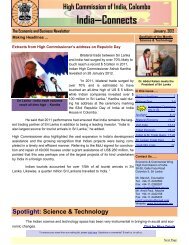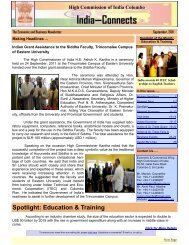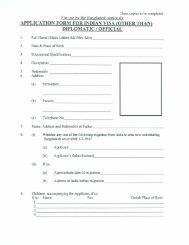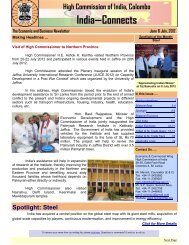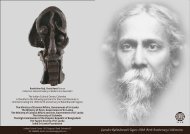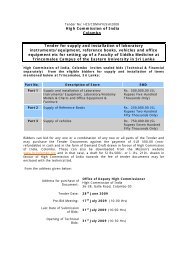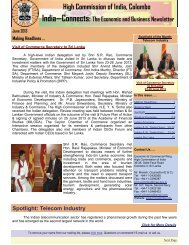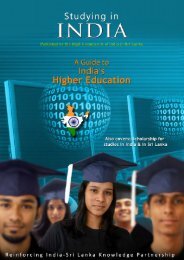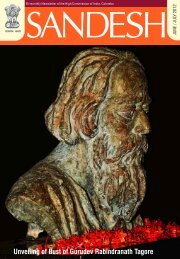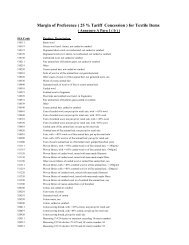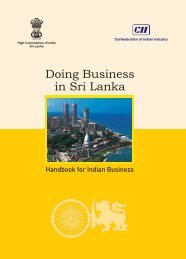Papers presented at the International Buddhist Conference, March ...
Papers presented at the International Buddhist Conference, March ...
Papers presented at the International Buddhist Conference, March ...
Create successful ePaper yourself
Turn your PDF publications into a flip-book with our unique Google optimized e-Paper software.
Theriya Parampara re<strong>presented</strong> by <strong>the</strong> Mahavihara. “The disfavor<br />
with which Ceylon kings and monks viewed any encroachment by<br />
Vaitulya doctrines on <strong>the</strong> Theravada Buddhism of <strong>the</strong> Island had<br />
made it impossible for much exchange of scholarship to take place<br />
4<br />
between <strong>the</strong> two countries”.<br />
There are evidences to show th<strong>at</strong> Vaitulya-Vada and some form of<br />
Mahayana existed and become Vital time to time in Ceylon, Fahien,<br />
<strong>the</strong> famous Chinese pilgrim, tells us th<strong>at</strong> Mahavihara monks<br />
were opposed to <strong>the</strong> Mahayana teachings and adhered to <strong>the</strong><br />
teachings of Hina-yana. But in Abhayagiri school both vehicles<br />
5<br />
were studied. Fa-hien took with him a copy of Mahisasaka Vinaya,<br />
Dirghagama, Samyuttagama and Samyutta-sañcaya-pitaka, all<br />
6<br />
written in Sanskrit. It shows th<strong>at</strong> in Srilanka <strong>the</strong>re existed school<br />
like Mahisasaka and Sanskrit was <strong>the</strong> language used by some<br />
<strong>Buddhist</strong> sects in Srilanka. According to Nikaya Sangraha,<br />
Mahadaliy<strong>at</strong>issa accepted <strong>the</strong> teachings of Dhammarucinikaya of<br />
Vajjiputtaka sects in India and <strong>the</strong>nceforth <strong>the</strong> Abhayagiri school<br />
7<br />
was known as Dhammruchinikaya.<br />
However no trace of <strong>the</strong>ir liter<strong>at</strong>ure is left. Most probably <strong>the</strong><br />
rulers of Ceylon, owing to <strong>the</strong>ir strong <strong>at</strong>tachment to Theriya<br />
Parampara saw to it th<strong>at</strong> not a vestige of <strong>the</strong>ir heretical teachings<br />
should remain. There are many examples of <strong>the</strong> rigid <strong>at</strong>titude of <strong>the</strong><br />
Theravadins against <strong>the</strong> thoughts of o<strong>the</strong>r <strong>Buddhist</strong> sects. In a<br />
8<br />
passage of Samantapasadika it is reported th<strong>at</strong> during <strong>the</strong> reign of<br />
Srilankan king Bh<strong>at</strong>iya (38-66 A.D.) a dispute arose between <strong>the</strong><br />
monks of <strong>the</strong> Abhayagiri and <strong>the</strong> Mahavihara schools for a rule of<br />
<strong>the</strong> Vinaya. The king appointed a minister, <strong>the</strong> Brahmana<br />
Dighakarayana to decide <strong>the</strong> case. This Brahma˜a was wise and<br />
versed in o<strong>the</strong>r languages: -<br />
“Pandito Bhasantarakusalo”.<br />
Thus this person was not reputed for <strong>the</strong> knowledge of Vinaya<br />
rules but was proficient in languages. From this fact same9<br />
scholars infer th<strong>at</strong> <strong>the</strong> main reason of <strong>the</strong> differences between <strong>the</strong><br />
monks of <strong>the</strong>se two monasteries was more of a linguistic n<strong>at</strong>ure<br />
than of a doctrinal. The Abhayagiri Vihara was gre<strong>at</strong>ly influenced<br />
by Mahayana in which <strong>the</strong> texts were preserved in Sanskrit, not in<br />
Pali. The choice of a Brahmana minister well versed in Sanskrit<br />
also confirms this hypo<strong>the</strong>sis. There are also no traces of any<br />
impact of Srilanka’s Theriya Parampara on <strong>the</strong> Philosophical<br />
writings of Vaibh<strong>at</strong>ikas, Sautrantikas, Yogacara and Madhyamika<br />
schools of Indian Buddhism.<br />
It is probable th<strong>at</strong> regular exchange of visits by Indian and<br />
Srilankan monks must have facilit<strong>at</strong>ed some sort of interaction<br />
between two n<strong>at</strong>ions. Although impact of <strong>the</strong>se interactions are not<br />
clearly visible and is not firmly admitted by <strong>the</strong> Theravada<br />
tradition of Srilanka, however major shift in <strong>the</strong> Atthak<strong>at</strong>has from<br />
<strong>the</strong> original position of <strong>the</strong> Tipitaka concerning <strong>the</strong> Buddhahood or<br />
Buddha-n<strong>at</strong>ure, <strong>the</strong> introduction of <strong>the</strong> process of cognition (cittavithi)<br />
not discussed in <strong>the</strong> early Abhidhamma and install<strong>at</strong>ion of<br />
<strong>the</strong> icons of Buddha or <strong>the</strong> worship of <strong>the</strong> Buddha Pr<strong>at</strong>ima etc.<br />
seem to show some sort of impact of Indo-Ceylonese interface.<br />
9<br />
According to some western writers Buddhaghosa, who was<br />
acquainted with <strong>the</strong> developed <strong>Buddhist</strong> doctrines in India, has an<br />
interesting doctrine of <strong>the</strong> rel<strong>at</strong>ions of sanna, (perception), vinnana<br />
and panna and gave idealistic interpret<strong>at</strong>ion of aspects of sens<strong>at</strong>ion<br />
and feeling which in <strong>the</strong> early writings was perceived as an<br />
interaction of m<strong>at</strong>erial and psychic factors. The Vaibh<strong>at</strong>ikas and<br />
Sautrantikas also accepted <strong>the</strong> real interaction of m<strong>at</strong>ter and mind<br />
in <strong>the</strong> process of knowing. It seems th<strong>at</strong> Buddhaghosa accepted in<br />
effect vijnanavada doctrine propounding th<strong>at</strong> object of perception<br />
is mere subjective (ideal or reflection of mind). The concepts of<br />
Bhav<strong>at</strong>ga and Citta-vithi also seem to be an outcome of <strong>the</strong> Indo-<br />
Ceylonese Cultural interface.<br />
Age-long cultural interaction between India and Srilanka had deep<br />
impact on <strong>the</strong> linguistcal aspects of Ceylonese culture. It may be<br />
seen clearly in <strong>the</strong> form of gradually increasing influence of<br />
Sanskrit Language on Sinhali and l<strong>at</strong>er Pali writings. In <strong>the</strong><br />
linguistic survey of Srilanka it is clearly observed by scholars th<strong>at</strong><br />
besides Sinhali and Pali, Classical Sanskrit was gradually coming<br />
into use and rapidly became <strong>the</strong> medium for <strong>the</strong> study of scholarly<br />
secular works composed in India. It is interesting to observe th<strong>at</strong><br />
unlike Mahayanists and Sarvastivadins of India Srilanka’s<br />
Theravadains did not replace Magadhi or Pali by Sanskrit, nor did<br />
<strong>the</strong>y adopt hybrid or mixed Sanskrit which was adopted for <strong>the</strong><br />
Mahayana sutras in India. Most probably <strong>the</strong> adapt<strong>at</strong>ion of<br />
Sanskrit by Srilankans is not an outcome of <strong>the</strong> interaction between<br />
<strong>the</strong> <strong>Buddhist</strong>s of India and Srilanka. It is assumed th<strong>at</strong> intim<strong>at</strong>e<br />
rel<strong>at</strong>ions existed between <strong>the</strong> Tamils and <strong>the</strong> Sinhalese settlers<br />
from an early period of <strong>the</strong> history of Ceylon and <strong>the</strong>re presence in<br />
<strong>the</strong> island might have proved helpful in <strong>at</strong>tracting <strong>the</strong> intellectuals<br />
for <strong>the</strong> study of Sanskrit.<br />
It seems probable th<strong>at</strong> in <strong>the</strong> beginning Sanskrit language<br />
influenced <strong>the</strong> vocabulary and syntax of Sinhali. Soon after<br />
learning <strong>the</strong> elements of Sanskrit <strong>the</strong> Ceylonese writer introduced<br />
Sanskrit forms in <strong>the</strong>ir writings of high Sinhalese. L<strong>at</strong>er on<br />
Sinhlese authors composed several works in pure Sanskrit.<br />
Buddhadasa a king of Srilanka, compiled his memorable work<br />
“Sarartha-sangraha in pure Sanskrit”. Candragomi vyakarana<br />
pañjika aand shabdartha cinta] <strong>the</strong>se two works of Sanskrit<br />
grammar were written by Elder r<strong>at</strong>nashrijñana also called<br />
r<strong>at</strong>nam<strong>at</strong>ipada in about 11th Century A.D. Kumara Dh<strong>at</strong>usena or<br />
Kumaradasa composed a melodious Sanskrit poem<br />
“Janakiharana.” Composition of such works in pure Sanskrit<br />
indic<strong>at</strong>es th<strong>at</strong> more <strong>at</strong>tention began to be given to secular subjects<br />
and Sanskrit comes to be regarded as being of <strong>the</strong> first importance<br />
for th<strong>at</strong> purpose.<br />
The Ceylon Pali Writings of l<strong>at</strong>er periods –<br />
Mahabodhivamsa, written in <strong>the</strong> last quarter of 10th century by a<br />
Ceylonese monk Up<strong>at</strong>issa marks <strong>the</strong> beginning of <strong>the</strong> period of<br />
Sanskritized Pali. There are distinct traces of <strong>the</strong> influences of<br />
Sanskrit on <strong>the</strong> Pali language of <strong>the</strong> book. Sometimes Pali words<br />
are used in <strong>the</strong>ir Sanskrit sense, sometimes we see <strong>the</strong> use of such<br />
Sanskrit words which are not found <strong>at</strong> all in <strong>the</strong> old Pali liter<strong>at</strong>ure.<br />
Some of <strong>the</strong>m are: -<br />
i)<br />
11<br />
Udite Bhuvanasekhare<br />
ii) Parap<strong>at</strong>a-caranap<strong>at</strong>alarage<br />
It is clear th<strong>at</strong> <strong>the</strong> style of this work is different from earlier<br />
Sinhalese Pali writings. The style is artificial and <strong>the</strong> whole tone<br />
and manner of this work betray <strong>the</strong> beginning of a tendency to use a<br />
kind of sanskritized Pali. Even <strong>the</strong> authors of such Pali works as<br />
D<strong>at</strong>havamsa and Saddhammopayana make frequent use of such<br />
Pali words which were derived or phonetically transformed from<br />
Sanskrit. They turned into Pali several Sanskrit words <strong>the</strong>y found<br />
ei<strong>the</strong>r in Amarakosa or in <strong>the</strong> course of <strong>the</strong>ir readings of certain<br />
Sanskrit poetic compositions and used <strong>the</strong>m as Pali words.<br />
13 14 15 16<br />
Use of words like Antarala, avad<strong>at</strong>a, cam¨p<strong>at</strong>i, dhavala,<br />
17 18 19 20 21<br />
N¨tana, nikhila, bhuwana, saroruha, dijapavara and<br />
22<br />
jamp<strong>at</strong>i, etc., are <strong>the</strong> clear evidences of sanskritiz<strong>at</strong>ion of Pali in<br />
l<strong>at</strong>ter Pali writings of Srilanka.<br />
23<br />
Uses of such words as sam<strong>at</strong>ta (Sanskrit samapta) cittañceti24<br />
25<br />
inseted of cittaña<strong>at</strong>i, kriyacittani instead of kiriya-cittani and<br />
26<br />
vuccare in <strong>the</strong> Abhidhamm<strong>at</strong>thasangaho also indic<strong>at</strong>e <strong>the</strong> same<br />
tendency.<br />
12<br />
90



